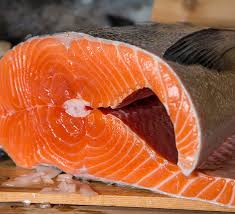Salmon is a versatile and nutrient-rich fish that can be prepared in countless ways. However, achieving the perfect balance of flavor and texture requires some skill and know-how. This article will guide you through the best methods to cook salmon, ensuring every bite is delicious and satisfying.
1. Choose the Right Cut of Salmon

The cut of salmon you choose affects its flavor and cooking method:
- Fillet: Great for pan-searing, baking, or grilling.
- Steak: Ideal for grilling or broiling due to its thickness.
- Whole Salmon: Best for roasting or poaching when serving a crowd.
2. Seasoning Salmon: Keep It Simple

Salmon’s natural flavor shines with minimal seasoning.
- Classic seasoning: Salt, pepper, olive oil, and a touch of lemon.
- Enhance flavor with herbs like dill, parsley, or thyme.
- For a bold taste, try marinades with soy sauce, garlic, honey, or mustard.
3. Popular Cooking Methods

a. Pan-Seared Salmon
- Heat a non-stick skillet with olive oil or butter over medium-high heat.
- Place the salmon skin-side down and cook for 4-5 minutes.
- Flip and cook the other side for 2-3 minutes until golden and crisp.
b. Baked Salmon
- Preheat the oven to 375°F (190°C).
- Place the salmon on a baking sheet lined with parchment paper.
- Season as desired and bake for 12-15 minutes, depending on thickness.
c. Grilled Salmon
- Preheat the grill to medium-high heat.
- Oil the grates to prevent sticking.
- Grill the salmon for 4-5 minutes on each side until charred and flaky.
d. Poached Salmon
- Bring a pot of water with aromatics (lemon, bay leaves, peppercorns) to a simmer.
- Add the salmon and cook for 10 minutes or until just cooked through.
4. Common Mistakes to Avoid

- Overcooking: Salmon should be cooked to an internal temperature of 145°F (63°C). Overcooking results in dryness.
- Skipping Rest Time: Allow the salmon to rest for a few minutes after cooking to let the juices redistribute.
- Using High Heat Without Monitoring: Salmon cooks quickly, so keep a close eye on it.
5. Serving Suggestions

- Pair salmon with fresh salads, roasted vegetables, or creamy mashed potatoes.
- For an Asian twist, serve with rice and stir-fried vegetables.
- Add a side of tartar sauce, lemon butter, or a dill yogurt sauce for extra flavor.
Conclusion
Cooking salmon to perfection is easier than you think when you follow these tips. Whether you prefer it pan-seared, baked, or grilled, the key is to let the salmon’s natural flavor shine. Experiment with seasonings and sides to create a dish that suits your taste. With a little practice, you’ll master the art of preparing this delicious and healthy fish.


0 Comments